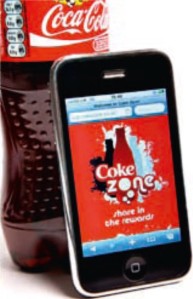New Zealanders have long been keen collectors of loyalty points for everything from their retail shopping to credit card use and airline flights. The success of these programmes has seen them quickly added to the arsenal of FMCG marketing professionals. But it’s not just entrepreneurial grocery brands at the bleeding edge of the new wave that are adopting loyalty programmes; the core of the FMCG market has recognised their value, with two multinational companies, Coca-Cola and Procter & Gamble, leading the charge. Both are our clients.
So what makes these programmes so valuable for those implementing them? It all boils down to data— actual customer transaction information on who bought what, when, where and for how much—that can then be used to determine which people might be enticed to buy next, and craft one-to one communications to get that sale.
From Flat to Fizzing
Many soft-drink brands are caught in the feast-or famine cycle of traditional promotion marketing. And the indiscriminate impact of these promotions leads to unpredictable market share lifts and losses across key segments. In both Britain and the US, Coca-Cola found itself in a cycle of price promotions with no increase in sales revenue or customer loyalty. What’s more, those programmes became increasingly expensive to plan and execute.

In the UK, Coke dealt to this with one of the best customer loyalty programmes of its type. The aim was to keep customers engaged between promotions to keep sales buoyed. We were able to leverage the Coca-Cola brand equity along with a large customer database to secure some enticing reward offers. Its customer loyalty programme, Coke Zone, is a real-world equivalent of click-throughs.
Unique codes are printed inside the labels of all Coke bottles and multi-packs. Consumers enter these online or via text and, in doing so, create a continuous transaction history and picture of who they are. Coke can then tailor its marketing and offers accordingly. The result was increased volume year-over-year, with loyalty communication offers rising to an open rate of 49% and a click-through rate of 71%.
Coke has redefined how a loyalty programme website should work. So many consumers are now entering codes that Coke Zone is the most visited FMCG website in the UK. It has eight times more visitors than Pepsi and they spend ten times longer on the Coke site than its rival’s portal.

Redefining Online Rewards
Coca-Cola faced a similar situation in the US. Its existing points-based programme was expensive and lacked a sound rewards and communications strategy. The My Coke Rewards ‘build-it-and they- will come’ approach to consumer engagement was more than just a bad assumption—its old rewards strategy was not financially sustainable.
The programme was reworked and its re-energized version saw a 16.8% increase in code entry online. Logins to mycokerewards.com increased their open rate by more than 220%, indicating multiple logins, and the rise in code-entries-per member reached 108% over the control group.
A more refined approach
For another of our clients, Proctor & Gamble in the USA, refining its already effective customer-loyalty strategy delivered better results. The manufacturers of Pampers nappies, Proctor & Gamble had tested loyalty marketing and knew the strategy would work. Again, customers went online to enter unique codes printed inside each Pampers pack. The challenge was to refine the strategy and improve the programme. Using data already gathered allowed P&G to intervene at vulnerable switch points where a customer might be tempted to move to a competitor’s brand, and also at key points in their relationship with the Pampers brand. Because Pampers products are only relevant to consumers for a short period of time, the aim was to maximise that timeframe and build a relationship with parents. Carlson’s solution took the best of what airlines and credit card companies had already learned and applied it to the technology platform, consumer experience, rewards, partners, segmentation and trigger communications. The outcome has been improved results for Pampers on all fronts. Active participation among consumers has increased by 20%. The efficiency of the programme’s rewards budget improved by 10 percent and the overall ROI rose by 12.5%.
Our results for our CPG clients:
- 21% increase in share amongst participating consumers
- 12.5% volume increase year on year
- Revenues from strategic partnerships
1 COMMENTS:
-
So the question is, are product-specific programs such as Coke Zone sustainable in this neck of the woods? I can only presume that lack of scale has prevented Coke undertaking anything similar to date in Australia or New Zealand? There are a few eyes in Australia on the recently launched
Nescafe Cup of Rewards program. It will be interesting to see if the average household’s instant coffee consumption is enough to garner interest in the program, discussed further here.